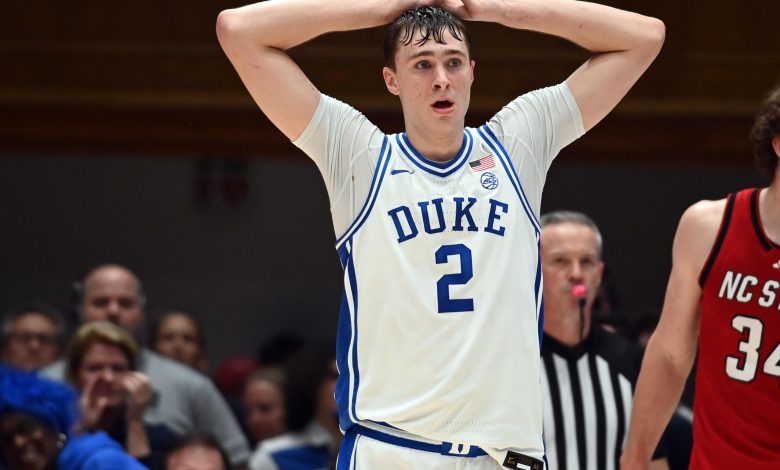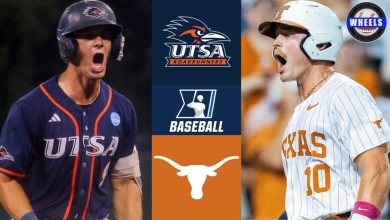Cooper Flagg has an NIL valuation of $4.8 million, the highest valuation in college basketball.

In the fast-paced and ever-evolving world of college sports, one player has managed to capture the attention of the basketball world and secure a major financial milestone even before his college career has truly begun. Cooper Flagg, a highly touted high school basketball prospect, has set a new bar in the world of Name, Image, and Likeness (NIL) deals with a staggering valuation of $4.8 million, making him the highest-valued player in college basketball.
Flagg’s rise to prominence in the basketball world has been meteoric, and his NIL valuation is a testament to his immense talent, marketability, and potential both on and off the court. At just 17 years old, Flagg has already drawn comparisons to some of the NBA’s biggest stars, and his college decision to play for Duke University has further fueled excitement surrounding his future. However, the story of his NIL valuation isn’t just about his on-court abilities—it’s also about the rapidly changing landscape of college athletics and the way athletes like Flagg are capitalizing on their popularity and marketability in a way that was previously unimaginable.
The Rise of Cooper Flagg: A New Kind of College Basketball Superstar
Before delving into the specifics of Cooper Flagg’s NIL valuation, it’s important to understand how he has become one of the most talked-about players in college basketball even before stepping foot on a college court. Flagg, who hails from the state of Maine, is a versatile forward known for his rare combination of size, athleticism, and basketball IQ. Standing at 6’9″ with a wingspan that seems to stretch on for days, Flagg has been lauded for his ability to guard multiple positions, score at all levels, and make his teammates better. His combination of defensive prowess, rebounding ability, and scoring touch makes him a unique prospect in today’s game.
Flagg first gained national attention during his high school career, where he dominated competitions and led his team to victory on several occasions. As a highly ranked recruit, he quickly rose to prominence on the recruiting circuit and became one of the top players in his class. His high school highlight reels are filled with jaw-dropping plays—contested blocks, highlight dunks, smooth jump shots—all of which further solidified his status as one of the best players in the country.
What sets Flagg apart from many other top recruits is not just his on-court ability but his level-headedness and maturity off the court. Throughout his recruitment process, he was recognized for his strong work ethic, leadership qualities, and grounded attitude. These qualities made him a highly sought-after prospect for top college basketball programs, and ultimately, Duke University emerged as the school that would have the honor of developing him into the future NBA star many expect him to become.
The Emergence of NIL and Its Impact on College Athletes
The concept of athletes profiting from their name, image, and likeness was once a distant dream for college athletes. For decades, NCAA regulations prohibited college athletes from profiting off their athletic abilities, whether through sponsorships, merchandise, or social media endorsements. However, in July 2021, the NCAA officially lifted the ban on NIL rights, allowing college athletes to profit from their name, image, and likeness while still maintaining their eligibility to play. This decision created a paradigm shift in the world of college sports, providing athletes with newfound financial opportunities that were previously unavailable.
Since the introduction of NIL, athletes in various sports have capitalized on their popularity by signing endorsement deals, appearing in commercials, and promoting products on their social media platforms. The world of NIL has fundamentally altered the financial landscape for college athletes, and some have already amassed significant earnings through their endorsements and sponsorships. The NIL landscape is still relatively new, but it has already made stars out of college athletes in a way that was never seen before.
For basketball players, the opportunities to earn through NIL are particularly lucrative. The popularity of college basketball, the widespread exposure of the NCAA Tournament, and the growing number of college basketball fans all contribute to the immense marketability of top players. With social media platforms providing athletes with direct access to millions of fans, the earning potential for stars like Cooper Flagg has exploded.
Cooper Flagg’s $4.8 Million NIL Valuation: What It Means
Cooper Flagg’s NIL valuation of $4.8 million is the highest of any player in college basketball, a remarkable achievement for someone who has yet to play a single game for Duke. His valuation surpasses those of other notable college basketball stars, including players who have already established themselves in the NCAA, and it places him on the same level as some of the most prominent names in sports.
Flagg’s NIL valuation is based on several factors, including his popularity, the level of his on-court performance, his social media following, and his overall marketability. Let’s break down these elements to better understand how Flagg achieved such a remarkable valuation.
- Talent and Potential: At the heart of Flagg’s NIL success is his exceptional basketball talent and potential. As one of the top recruits in the country, Flagg is expected to make an immediate impact at Duke and compete for top honors in college basketball. His combination of size, athleticism, and versatility makes him an intriguing prospect for both college basketball fans and NBA scouts. His ability to affect the game in multiple ways—whether it’s blocking shots, scoring in transition, or hitting clutch shots—gives him the kind of versatility that teams covet at the next level.
- Marketability: Flagg is not just a basketball player—he is a brand in the making. His marketability goes beyond his skill set on the court; it extends to his personality, work ethic, and ability to connect with fans. In today’s NIL era, athletes who can cultivate a strong personal brand have an enormous advantage when it comes to attracting sponsorships and endorsements. Flagg’s clean image, humble attitude, and ability to perform under pressure make him a highly marketable individual for brands looking to connect with young, sports-savvy audiences.
- Social Media Presence: One of the driving forces behind Flagg’s NIL valuation is his massive social media following. In today’s digital age, social media is a powerful tool that allows athletes to directly connect with their fans and expand their brand. Flagg has garnered a substantial following on platforms like Instagram, Twitter, and TikTok, where he shares highlights, training videos, and glimpses of his personal life. This online presence makes him an attractive figure for brands looking to promote their products to a young, engaged audience. Brands are increasingly looking to sign deals with athletes who have large followings on social media, and Flagg fits the bill perfectly.
- Duke’s Visibility and Legacy: Duke University is one of the most recognizable names in college basketball. The Blue Devils have a storied history, a massive fanbase, and a global following. Playing for Duke significantly enhances an athlete’s exposure and marketability. Cooper Flagg’s decision to join Duke further increases his NIL valuation, as the school’s national prominence ensures that his performances will be widely watched and analyzed. Duke’s high-profile games and its visibility during March Madness are prime opportunities for Flagg to showcase his skills and further grow his brand.
- Endorsement Opportunities: Thanks to the lifting of the NCAA’s NIL restrictions, Flagg now has the ability to sign endorsement deals with companies that want to leverage his popularity and marketability. He is already positioned to sign lucrative deals with major brands, including athletic companies, sports media outlets, and lifestyle brands. Given his skill set, his potential for success, and his growing online presence, Flagg is a prime candidate to become a household name in the world of NIL.
The Broader Impact of Flagg’s NIL Valuation
Cooper Flagg’s $4.8 million NIL valuation is not just a significant moment for the player himself; it also represents a broader shift in the landscape of college athletics. Flagg’s massive earning potential is a clear indicator that the future of college sports will look very different from the past. The introduction of NIL rights has given athletes the ability to earn a fair share of the revenue generated by their performances, and as more and more players like Flagg break new records in terms of NIL valuation, we can expect to see a seismic shift in how college athletes are compensated.
Flagg’s valuation also highlights the growing importance of recruiting and the role that NIL deals now play in a player’s decision-making process. Elite recruits, like Flagg, will increasingly consider the potential for NIL earnings when choosing a college program. As the NIL landscape continues to evolve, schools and programs will need to adapt and find ways to support their athletes in capitalizing on these opportunities. For a school like Duke, which has long been a powerhouse in college basketball, Flagg’s NIL success is a testament to the program’s ability to attract top-tier talent both on and off the court.
Cooper Flagg’s $4.8 million NIL valuation is just the beginning of what promises to be an exciting and lucrative college basketball career. As one of the top prospects in the country, Flagg’s on-court abilities are sure to continue to impress, and his growing personal brand and marketability ensure that he will remain a dominant figure both in college basketball and in the world of NIL deals. Flagg’s rise is a perfect example of how the world of college athletics is changing, and his success is likely to inspire a new generation of athletes to take advantage of the opportunities provided by NIL. For Cooper Flagg, the future looks incredibly bright—not just on the basketball court, but as one of the most marketable athletes in the world.









